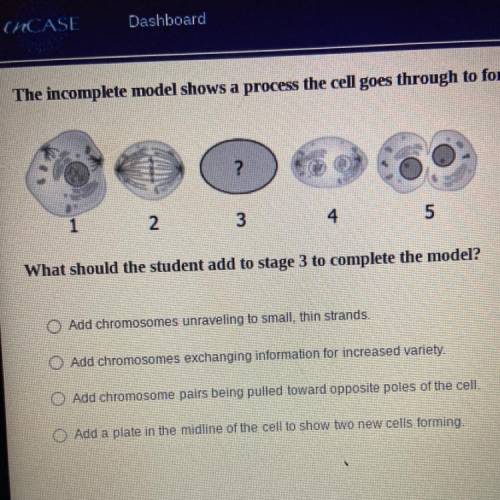
What should the student add to stage 3 to complete the model?
A. Add chromosomes unraveling to small, thin strands.
B. Add chromosomes exchanging information for increased variety.
C. Add chromosomes pairs being pulled toward opposite poles of the cell.
D. Add a plate in the midline of the cell to show two new cells forming.


Answers: 3


Another question on Biology

Biology, 21.06.2019 19:40
What does it mean for a cell membrane to be selectively permable
Answers: 1

Biology, 22.06.2019 01:00
Talking listening and reacting non verbally are all part of communicating
Answers: 2

Biology, 22.06.2019 02:30
Drag each tile to the correct box. arrange the phases of mitosis in the correct order. 1 (condensation of chromosomes) 2 (separation of chromosomes) 3 (formation of spindle fibers) 4 (alignment of chromosomes in the center of the cell) 5 (pinching of the cell membrane)
Answers: 2

Biology, 22.06.2019 03:00
To answer this question, researchers studied populations of the dusky salamander (desmognathus ochrophaeus) living on different mountain ranges in the southern appalachian mountains. the researchers tested the reproductive isolation of pairs of salamander populations by leaving one male and one female together and later checking the females for the presence of sperm. four mating combinations were tested for each pair of populations (a and b)—two within the same population (female a with male a and female b with male b) and two between populations (female a with male b and female b with male a). the proportion of successful matings for each mating combination was measured. for example, when all the matings of a particular combination were successful, the researchers gave it a value of 1; when none of the matings were successful, they gave it a value of 0. then the researchers calculated an index of reproductive isolation that ranged from 0 (no isolation) to 2 (full isolation). the reproductive isolation value for two populations is the sum of the proportion of successful matings of each type within populations (aa + bb) minus the sum of the proportion of successful matings of each type between populations (ab + ba). the table provides data for the geographic distances and reproductive isolation values for 27 pairs of dusky salamander populations.
Answers: 1
You know the right answer?
What should the student add to stage 3 to complete the model?
A. Add chromosomes unraveling to smal...
Questions

Computers and Technology, 05.03.2022 23:50





Social Studies, 06.03.2022 01:00


English, 06.03.2022 01:00

Mathematics, 06.03.2022 01:00




Mathematics, 06.03.2022 01:00


Chemistry, 06.03.2022 01:00


Business, 06.03.2022 01:00


Chemistry, 06.03.2022 01:00



